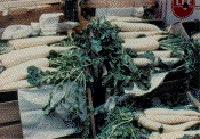Growing Daikon Successfully

Daikon is also known as Lobok, Oriental Radish, or Chinese Radish.
Daikon, Raphanus sativus, is in the Longipinatus group, a member of the Brassicaceae (mustard) family. Varieties include Mino Spring Cross (spring cultivar), Summer Cross No. 3, Chinese White (cylindrical), Chinese Rose (round), Celestial (cylindrical), and Tokinashi (a good all-season cultivar).
Daikon has extremely large roots. The Sakurajima variety, one of the largest, can weigh as much as 50 pounds. Most oriental radishes are in the 1 to 2 1/2 pound class at full maturity. Leaf spreads of more than 2 feet are common. The leaves differ from those of spring radish types in that they have great notches and they spread from the root tops in rosette fashion. Some varieties form large round or top-shaped roots, while others are cylindrical.
Other names and name origins: Lo pue (Hmong); daikon (Japanese); lor bark (Cantonese Chinese); labanos (Filipino); and cu-cai trang (Vietnamese).
Market Information
Use
This type of radish is usually cooked rather than eaten fresh, but it can be used raw in salads. In Japan, the radishes are often pickled.
Nutrition
Daikon contains no Vitamin A, 22 mg of Vitamin C, 0.6 g of protein, and 27 mg of calcium per 100 g raw, edible portion (about 1 cup of sliced daikon).
Culture
Culture is similar to that used for more familiar radish varieties. Plant the seed 3/4 inch deep in the fall (September through October) so the roots will enlarge in the cool months. The seeds and then the plants should be 4 to 6 inches apart in rows 3 feet apart. To compensate for the large root size, plant oriental radishes on high raised beds fortified with organic matter (compost). At each cultivation, work the soil higher and higher around the root as it grows. Most oriental radishes reach their best useable size in 60 to 70 days.
Harvest and postharvest practices
The USDA storage recommendations are 32¡F to 34¡F at 95 percent to 100 percent relative humidity, with an approximate storage life of four months.
Daikon Seed Sources
- W. Atlee Burpee & Company
300 Park Avenue
Warminster, PA 18974 - Johnny's Selected Seeds
Foss Hill Road
Albion, ME 04910 - Nichols Garden Nursery 1190 North Pacific Highway
Albany, OR 97321 - Park Seed Co.
Cokesbury Road
Greenwood, SC 29647-0001 - Seeds Blum
Idaho City Stage
Boise, ID 83706 - Shepherd's Garden Seeds Shipping Office, 30 Irene Street
Torrington, CT 06790
More Information
- Forsythe, Adrian. 1987. Of Radishes and Kings. Harrow-smith, May-June 1987, pp. 90-93.
- Rubatzky, Vincent, and Mas Yamaguchi. 1997. World Vegetables, 2nd ed. Chapman and Hall, New York, NY.
- Stephens, James. 1988. Minor Vegetables. Cooperative Extension Bulletin SP-40, University of Florida, Gainesville, FL.
Prepared by Claudia Myers.
Order the Specialty and Minor Crops Handbook by calling the Small Farm Center at (530) 752-8136.
